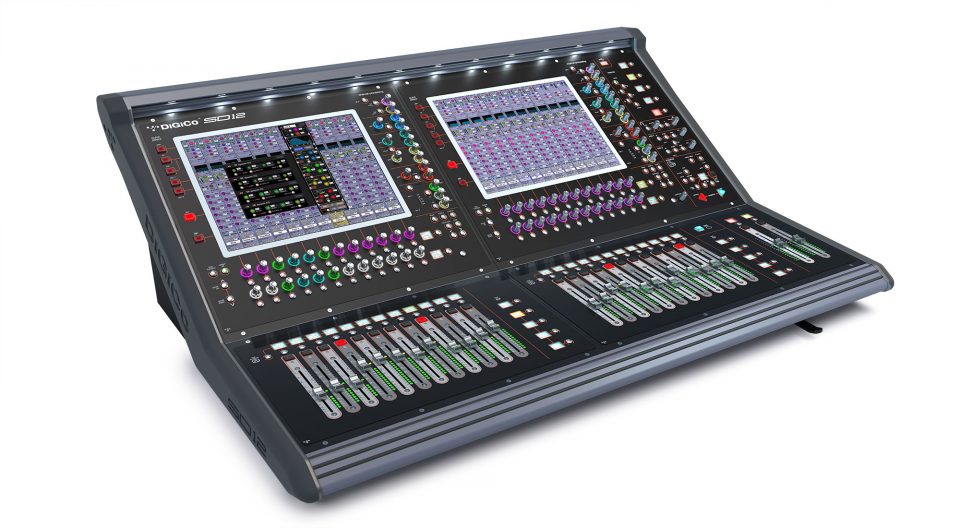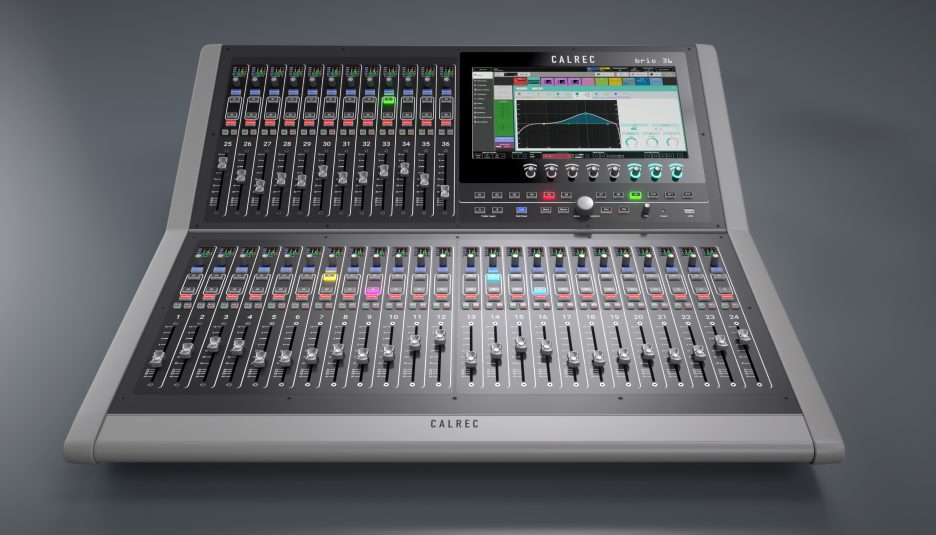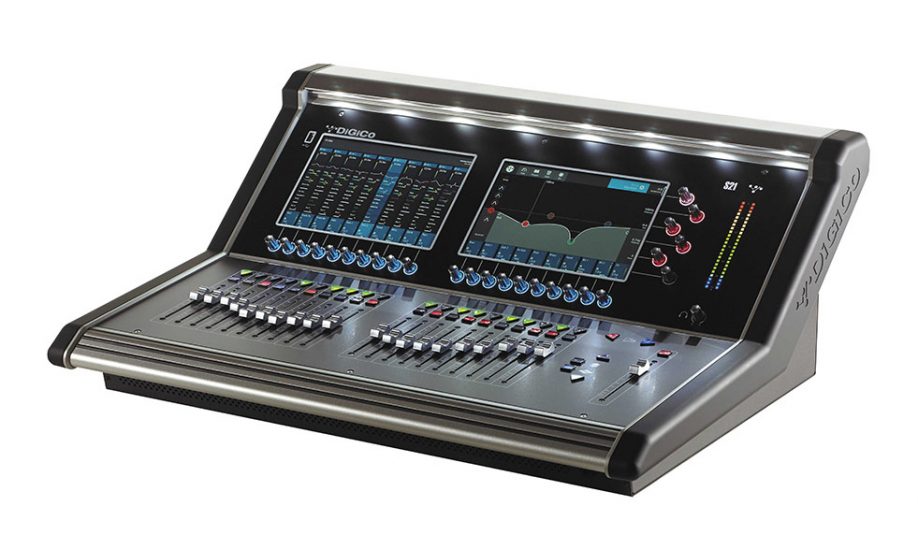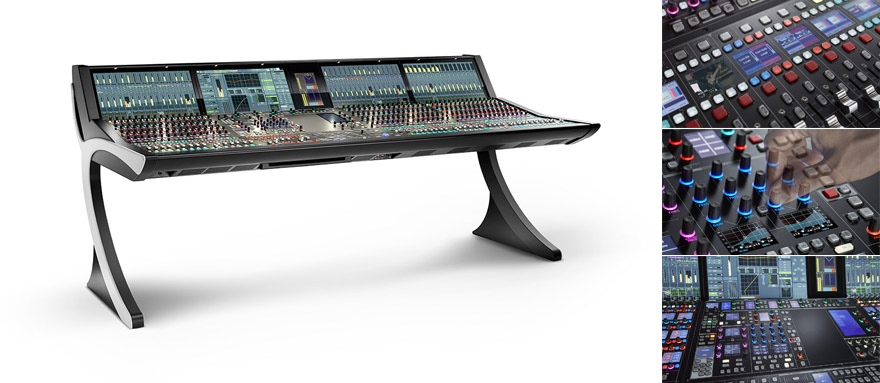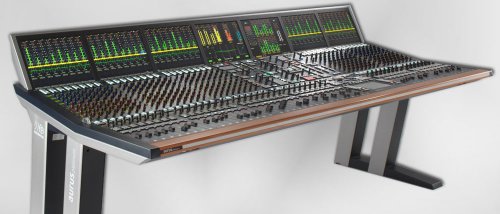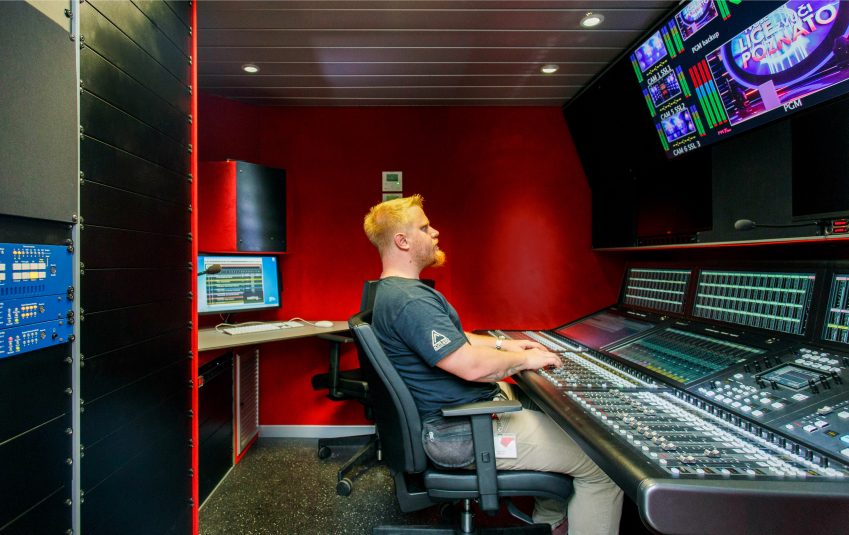Tech Focus: Audio Consoles
Story Highlights
By Dan Daley, Audio Editor, Sports Video Group
Part 1 — At-Home Production, IP Transport Are Key Trends
Basic console functionality will change as the technologies are increasingly linked
Two trends of potentially tectonic significance are affecting the evolution of the broadcast-audio console. The shift to so-called at-home, or REMI (remote integration), production is largely a case in which economics is driving workflow, in the process asking the mix console to do its job from hundreds or even thousands of miles away. At the same time, the entire broadcast industry has been migrating toward IP for signal transport, with audio, video, and control signals increasingly intertwined on networks. Manufacturers are adapting to both trends at varying paces, but all agree that basic console functionality will be altered.
Calrec, which continues to dominate remote-production market at the major-broadcast-network level, has recently accelerated its activities in both at-home production and IP. At NAB 2017 in April, the company showcased four new networking products: AES67/RAVENNA and AVB interfaces, a modular I/O Dante card with AES67 compatibility, and a SMPTE 2022-6 video interface. Calrec also introduced the RP1 remote-production engine, a 2RU core with integrated FPGA-based DSP enabling a console surface at another facility to control all mixing functionality, including IFB routing and remote-monitor mixes.
At-home production carries risks for the remote-production sector in general, potentially decreasing the need for the expensive, sophisticated trucks used for major sports productions. Given its market position, Calrec saw this as the right time to introduce the RP1, according to VP, Sales, Dave Letson.
“There is risk since it’s such a major change in workflow, but we also see it as an opportunity, as there will also be a need for more content,” he explains, adding that that can come from a wider range of sports productions created for distribution on a broader array of consumer devices. “There’s tremendous potential there, although, as an industry, we’re not quite there yet.”
Letson notes that Calrec has a dozen RP1 units in the field, including with Sky Sports, doing proof-of-concept demos. “Lately, [remote-production techniques and technology] have been the first thing that customers want to talk about.”
As for IP signal transport, Calrec has embraced the entire array of major solutions available, using the Alliance for IP Media Solutions (AIMS) “roadmap” as a guide. “It’s been several years of competing standards, and we still can’t see any one winning, so we decided a year and a half ago to support multiple standards,” Letson explains. “The long-term strategy is to keep the console at the center of the process, as the hub.”
Chris Fichera, VP, audio, Group One Ltd., which distributes Calrec and DiGiCo consoles in North America (Calrec, DiGiCo, and Allen & Heath collaborate through a joint venture), cites the new SD12 console and new Orange Box interface as examples of how the company is adapting to IP signal distribution: slowly and from the bottom up.
“We’re seeing activity in terms of trucks being designed around IP transport, from NEP and Game Creek, though those aren’t being used for major events yet, and Notre Dame is building an entire IP infrastructure,” he says. “But, as an industry, we’re not there yet. We haven’t crossed the barrier yet, and we’re about five years away from that.”
Fichera says the major networks are understandably cautious about jumping into the deep end with IP as the primary signal-transport modality: “You go live and something happens to a packet, how fast can you get that taken care of? No one really knows yet.” He cites reported interruptions with the live stream of the latest Super Bowl by Fox Sports and Comcast as reasons that the major networks are eyeing IP warily: “We’re still in the fiber game when it comes to connectivity, but we’re watching IP closely.”
The Two Trends Converge
Lawo has arguably been the most assertive when it comes to remote-production deployment. At EURO 2016, in what the company speculates may have been the largest-scale IP sports-broadcast deployment to date, its V_remote4 technology was used for the video and audio from 10 venues to the IBC in Paris, all based on a fully IP-based backbone. Other Lawo IP-based systems have reportedly been used by NBC Sports for Formula 1 races in Austin, TX, and by Fox Sports for the Americas Cup.
According to Head of Sales/Americas Jeffrey Ströessner, Lawo sees IP signal transport (audio, video, and control signals) and at-home workflows as deeply intertwined. “That is where the at-home–production scenario becomes most efficient, when paired with IP.” he explains. “Some of the workflows that make production efficient by centralizing production are not even possible without the utilization of IP technology.”
Although broadcast sports is a perfect candidate for rapid adoption of these converged trends, Ströessner acknowledges that it could take two or three years for sports to reach the level of implementation seen in other areas of media production, such as ingest, replay, and archiving. That’s due to the industry’s historic and implicit caution about adopting new platforms.
“I’ve done a few Olympics now,” he says, “and, once you’ve watched an Opening Ceremony being watched live by millions of people, you realize why broadcasters are not to eager for trial and error on that.”
However, he adds, broadcast’s economics makes IP’s uptake inevitable: “It will be used more and more at lower levels, at college and amateur sports [shows], and that will prove that it’s reliable as well as efficient.”
Wheatstone is using its WheatNet-IP audio network BLADE to touch on both IP distribution and at-home production. For example, the company’s literature suggests, the M4IP-USB networked microphone processor ingests up to four channels of audio and is also an I/O BLADE device on the WheatNet-IP audio network, allowing mic-processing adjustments locally at the venue or remotely from the IP audio console at home. I/O BLADEs, or access units, make up the WheatNet-IP and include audio resources that enable operators to manage almost any audio function from the network. Included in each I/O BLADE are two stereo 8×2 utility mixers and audio-processing tools to mix various sources from the network and process the resultant mixes. Because BLADEs also provide crosspoint control for the entire signal matrix, zero-latency IFB feeds can be created and controlled at any location.
“Audio routing, control, mixing, and processing are all done over the WAN through Wheatstone’s WheatNet-IP network of virtual-audio services,” a company spokesperson explains.
More Products Coming Faster
Studer by Harman has introduced two platforms to address the IP and at-home trends. At NAB 2017, the company introduced DIOS, I/O-routing–automation software designed to manage and simplify complex routing matrices within broadcast workflows. And it has repurposed an existing product line for the burgeoning at-home market: the Studer Micro Series compact, integrated digital audio broadcast and production mixing system was originally developed as an affordable radio-production solution.
“Essentially, DIOS enables you to bring different standards and APIs together into one ecosystem and connect third-party equipment that previously operated independently,” explains Mark Hosking, global sales director, Studer. “This opens up an entirely new world of options and significantly expands your routing capabilities. And a major benefit of the Studer Micro Series in REMI productions is the ability to put DSP on the ground at remote locations. This allows a greater range and degree of control from the central production point, and, with VPN control of the Micro from the studio, the mix engineer can control it remotely, and the latency is eliminated by having the DSP onsite. Combined with improved quality of service from the network ISP, it’s a very powerful combination for REMI production.”
Development of the console-product side of the IP and at-home equations is likely to accelerate. Now that intercompatibility formats are widely accepted, the only thing holding back product development will be imagination and budgets.
Part 2 — Products for Remote Mixing
Diversity — in size and functionality — marks the latest in the category
Remote–audio-mixing consoles for broadcast still constitute a relatively rarefied category at the high end of the market, but there is diversity within the group, thanks to increasing demand for variety in sizes and functionality. Here’s an overview of the leading contenders.
Calrec
The Brio console delivers a comprehensive broadcast feature set to support a wide breadth of broadcasters and is entirely self-contained with analog and digital I/O and GPIO built into the surface. In addition, a range of Hydra2 modules can be fitted to connect to and share audio over Calrec’s Hydra2 network. This means that Hydra2’s sophisticated management facilities can be used for network-wide control, including interfacing with multiple video- and audio-over-IP networks, such as SMPTE 2022, Dante, AES67, RAVENNA, and SoundGrid. This protects the system against future formats that may emerge and allows the console to sit on multiple networks simultaneously.
Brio also enables connectivity to other equipment in the Calrec Bluefin2 range: the Apollo, Artemis, and Summa consoles. Calrec’s flagship Apollo can handle 1,020 channel-processing paths, 128 program buses, 96 IFB/track outputs, and 48 auxiliaries. The Apollo control surface manages all these channels on up to 320 physical faders, and, with single- and dual-fader options, Apollo has a higher fader density within its footprint than any other console.
Artemis is based on the Apollo platform and uses the same Bluefin2 and Hydra2 core technologies. Available in four sizes, Bluefin2 gives Artemis Shine 680 channel-processing paths, Artemis Ray 456, Artemis Beam 340, and Artemis Light 240, with up to 128 program buses, 64 IFB/track outputs, and 32 auxiliaries. Artemis Light packs all this into a 4RU enclosure. Artemis’s integrated router means all I/O functions can be performed by Hydra2, using high-capacity crosspoint routers and a variety of I/O units.
Bluefin2 gives the Summa and Summa 128 consoles a pool of either 180 or 128 channel-processing paths, eight groups, four mains, 16 auxes, and 32 tracks. Summa’s considered control simplifies even complex workflow tasks, such as creating mix-minus feeds.
Designed with live sports broadcasting in mind, the RP1 remote-production unit’s engine is a 2RU core containing integrated, FPGA-based DSP, enabling a console surface at another facility to control all mixing functionality. The RP1 core manages all the processing for IFB routing and remote monitor mixes, and it does so locally with no latency. www.calrec.com
DiGiCo
The S Range of compact digital consoles has been expanded with the S31. A larger version of DiGiCo’s popular S21 console, it sports an expanded work surface with 10 additional faders for more control and a third 10-in. multitouch screen for faster access and more visual feedback. The S31 offers the same flexibility as the S21, with 24 mic inputs and 12 line outputs on the rear of the console for straightforward audio connection. There are also two DMI ports as standard, as well as a UB MADI interface for DAW recording.
DiGiCo’s new compact 2RU Orange Box is a simple-to-use audio-format converter with multiple options, allowing broadcasters to deploy DiGiCo Multichannel Interface (DMI) cards to create audio paths over a variety of interfaces. With two PSUs for redundancy and two slots to accommodate any of the 10 current interfaces available (Dante, Hydra2, BNC, Cat 5, Optocore, Aviom, ADC, AES, DAC, and SoundGrid), the “anything in, anything out” Orange Box allows conversion of almost any audio format to another. www.digico.biz/
Lawo
Lawo mixing consoles are IP-ready and support current and evolving industry standards for audio-, video-. and data-format interoperability. Offered in multiple configurations with physical console surfaces, channel capacity, and frames optimized for implementation ranging from mobiles and flypacks to large production complexes, the mc² Series comprises the recently introduced mc²96 Grand Production Console optimized for IP production environments; the mc²56, which is also available with optional surfaces providing extra free controls (mc²56xc) or dual faders (mc²56xt); and the all-in-one mc236.
The company also offers a range of solutions for remote-production and automated-mix applications: standalone cores; the mc2 Micro Core universal networked audio engine, the Compact Engine AES67 audio node with on-board DSP, and the new Power Core 1RU IP-based mix engine with modular I/O options. All the solutions can perform audio-mixing and routing functions under remote control of vision mixers or third-party automation systems and also offer several options for virtual (software-based) control panels that can be optimized to support specific workflows and do not require localized physical fader surfaces. Multiple stagebox I/O offerings support IP interfacing of analog and digital sources for remote-production applications. In addition to DALLIS modular frames, Lawo now also offers the A__line AoIP interfaces for managing analog, AES3, MADI, and RAVENNA/AES67 audio connections, including functionality for remote mic pre control and operation of audio-mix functions from a remote location using a browser-based interface that can be customized for specific workflows. All Lawo consoles, cores, stageboxes, control software, and Nova Series routers offer multiple configuration options with protocols supported for automation and studio/remote management applications, including the VSM Virtual Studio Manager broadcast-control and -monitoring system and SOUL (Seamless Orchestration and Unification Layer), the company’s newest offering for control of networked production infrastructures. www.lawo.com
StageTec
Stagetec’s three consoles for on-air broadcast share similar modular surface designs, DSP, and I/O-routing architecture. All feature hot-swap capability, up to four independently controlled mic splits, full redundancy up to double optical lines, light weight, and extremely low power consumption.
The flagship AURUS platinum multiformat production console is available with eight-96 faders and per-setup–scalable core resources featuring 218-822 or 128-32 mix buses at 48 kHz (176-386 or 128-32 mix buses at 96 kHz). In 5.1 and 7.1 surround sound, stereo and mono can be done simultaneously, with 5.1 on-board downmix/upmix capabilities and separate multiple-bus configurations. The console offers fully motorized fader dynamic automation and editable snapshot and scene automation.
The CRESCENDO platinum mixing console offers a slimmed-down control surface and price but with the DSP power available in the larger AURUS when needed. All controls are within easy reach of a seated operator. Snapshot and scene automation is extensive, with the ability to set glide times between snapshots. Audio-follow-video control muting and levels changes via external control are readily available through the NEXUS LOGIC system.
The ON AIR flex flexible mixing console is aimed at the radio and smaller TV-broadcast markets. The modular, flexible, and scalable system features control surfaces that can be laid out to the broadcaster’s specification for combo, studio, or edit operation. The work surface consists of self-contained fader modules (four in each and up to 24 faders maximum per system) and a monitor module. The browser-based GUI software runs on any PC linked via Ethernet to the controller unit mounted in the system frame.
Available next year, AVATUS is a fully IP-based large mixing console with 21-in. multitouch displays. Control elements and interfaces are connected through standard Ethernet. The control surface and other elements communicate via IP networks, enabling remote production. The interface is highly flexible, allowing customized function assignments. The console can be split, since the displays can be relocated as required. AVATUS provides more than 800 input channels and 128 sum buses. Channel formats range from mono to 7.1. Integrated features include the de-esser, implemented as an audio module; loudness metering; limiter; compressor; expander; gate, and the Stage Tec automixer. Control-surface sizes range between 12 and 96 channel strips. The AVATUS is based on standardized technologies and protocols, facilitating control by and integration with third-party devices. Interconnectivity with other systems will be further enhanced by implementing the AES70 standard. www.stagetec.com
SSL
System T is a fully networked broadcast-audio–production environment, designed from the ground up to provide the power to handle large-scale productions in a multiplatform delivery-driven future. It has an entirely IP-based networked control and audio infrastructure and a highly configurable architecture that can adapt to a huge range of applications and operator requirements. Routing and I/O is Dante-based, featuring Dante HC (high-channel) connectivity and full device discoverability. SSL’s pristine SuperAnalogue foundations combine with 64-bit floating-point processing and mixing to ensure unlimited audio headroom with the power to execute complete algorithms within a single sample. A range of hardware and software control interfaces can be placed anywhere on a network with up to three consoles or control interfaces accessing a single or fully mirrored redundant pair of Tempest processor engines. Multiple engines can be used on a single network. A single T80 Tempest Audio Engine can handle more than 3,000 inputs and 3,000 outputs and has a capacity of 800 fully processed audio paths.
There is a wide selection of network objects available to the System T environment. Control options, for example, range from large multi-operator surfaces incorporating the latest multi-gesture touchscreen technology to single fader-tiles and PC-based control software. The latest additions include the T25 Engine (reduced-capacity engine), the Tempest Control Rack (rack-mounted control system with optional fold-out touchscreen aimed at automated broadcast environments and mobile/remote broadcast applications), and the Network I/O: 32.24 (Dante stage rack with Dante-based isolated split features).
The SSL C10 HD Plus is a compact, midscale broadcast console with a user-friendly interface. The C10’s Blackrock Processor is built into the control surface, making it excellent for OB-vehicle installation. Production-assistant features include Dialogue Automix, 5.1 Upmix, DAW Control, and C-Play (an embedded dual-player playout system). C10 and its range of I/O provides system-wide integration with comprehensive connectivity options, compatibility for Grass Valley, Ross, Sony, and Mosart production-automation systems, compatibility with Riedel RockNet and Optocore installed audio networks, and interfacing to Dante IP audio networks via the SSL MADI-Bridge. www.solidstatelogic.com
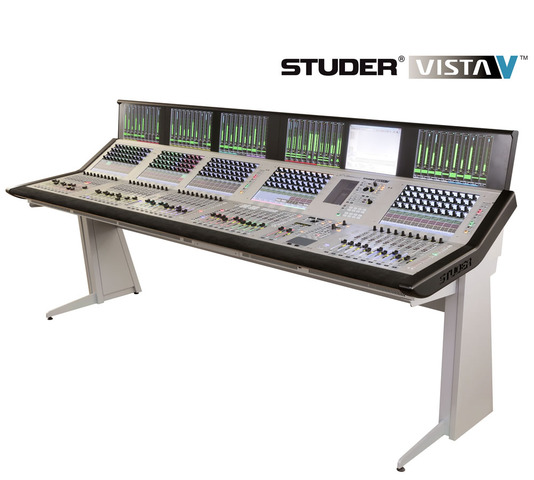 Studer
Studer
Vista Infinity Broadcast Mixing consoles, including the Vista V and X models, retain the patented Vistonics and FaderGlow user interface from previous products in the Vista line, providing control of 800 or more audio DSP channels and more than 5,000 inputs and outputs. At the heart of the system is the Infinity DSP core, which uses CPU-based processors to provide huge numbers of DSP channels for large-scale, high-resolution audio processing and mixing. This offers significant advantages, as CPU processing provides a scalable system, faster development of new signal-processing designs, huge channel counts, full system redundancy without a single point of failure, and the possibility of running third-party algorithms. The new Infinity DSP engine provides 12 A-Link high-capacity fiber digital audio interfaces, providing more than 5,000 inputs and outputs. A newly designed high-density I/O system, known as D23m, is used to break out these A-Link connections to standard analog, digital, and video interfaces. The A-Link interface also provides direct connection to the Riedel MediorNet distributed router, allowing many Infinity systems to be connected together with router capacities of 10,000 square or more. A key element in the design of the Infinity Series is to avoid the possibility of a single fault’s causing loss of audio, and, with four independent processors offering complete redundancy of the control surface with instant switchover between the main and standby CPU-based mixing cores, this is achieved without audio break. www.studer.ch
Wheatstone
Wheatstone is positioning its newly introduced IP console series — Dimension Three (Touch), Series Two, Series Four, D8-EX, large-format IP-64 — for the burgeoning at-home–production market. Any of these IP-based consoles can be located at the home or main studio with the WheatNet-IP audio network used for audio transport and control between the venue and main studio through a long-haul link. This makes it possible to trigger from the main studio any IFBs and mics at the sports venue and to send raw media down the line for final mixing. The IP console receives the raw audio across the long-haul link and through the WheatNet-IP network of virtual audio services for final mixing and production. With audio services such as mix-minus, audio processing, and automation control virtualized into software modules, rather than as fixed hardware on the console, all functions are seamlessly and easily accessible anywhere on the network. For instance, audio ingest can be done locally at the event, and levels can be controlled remotely from the studio IP console. Mixing and processing audio can be done locally or remotely in real time, and the WheatNet-IP audio network itself can serve as an IFB backbone routable by simply triggering crosspoints in the network. www.wheatstone.com/
